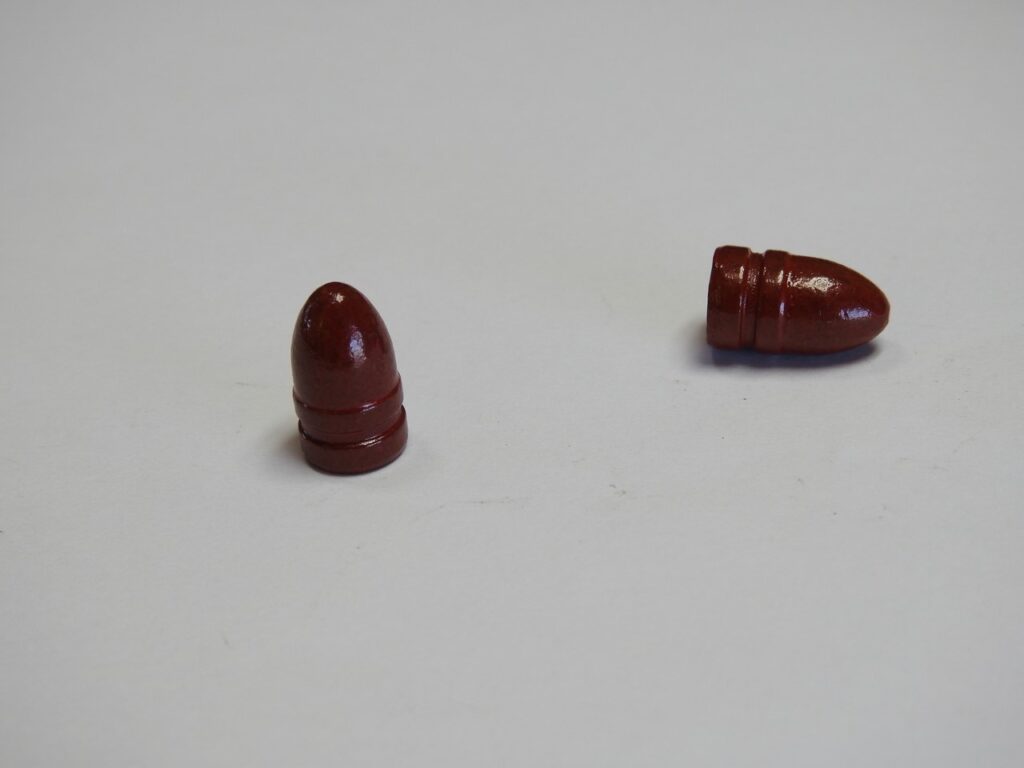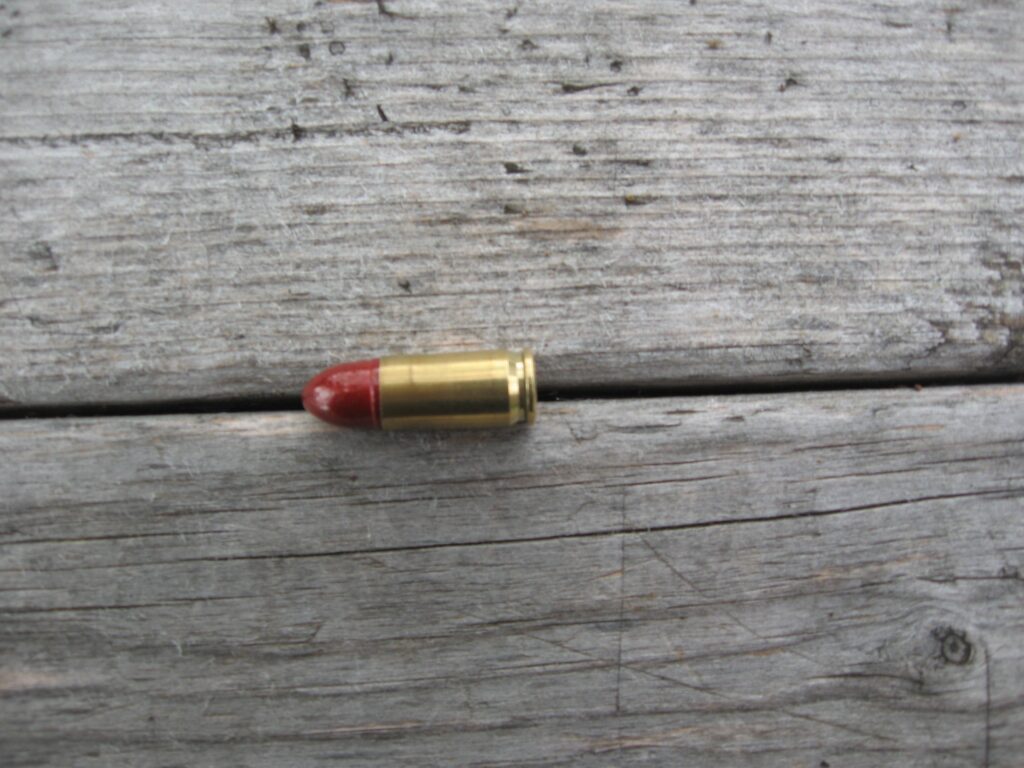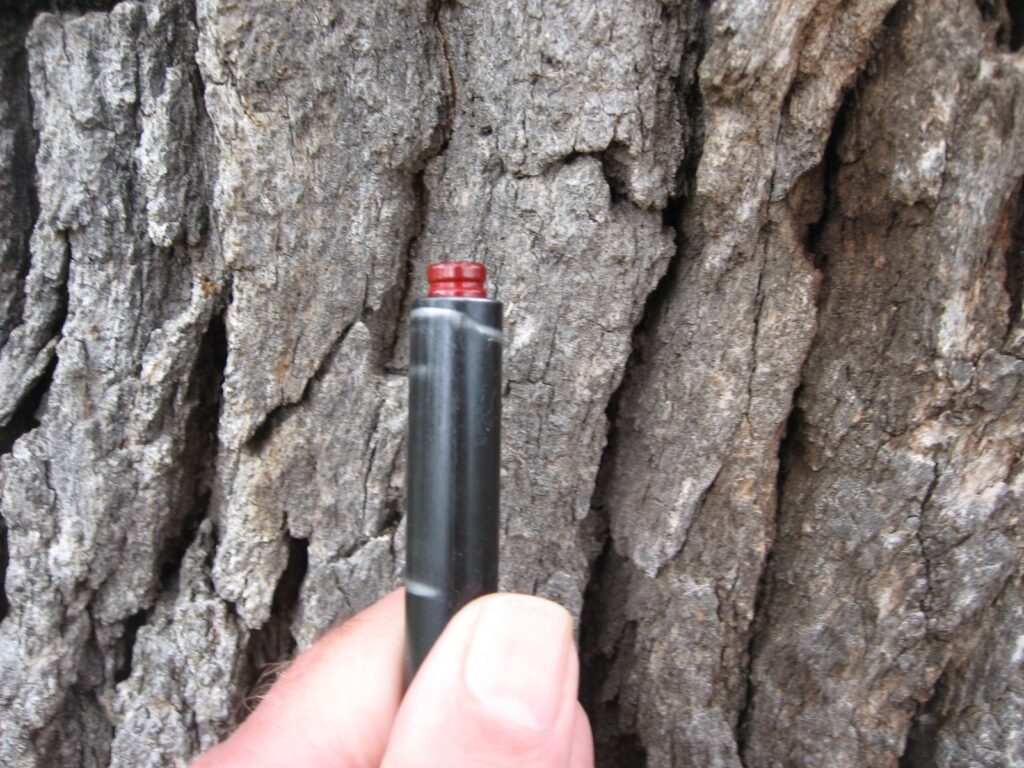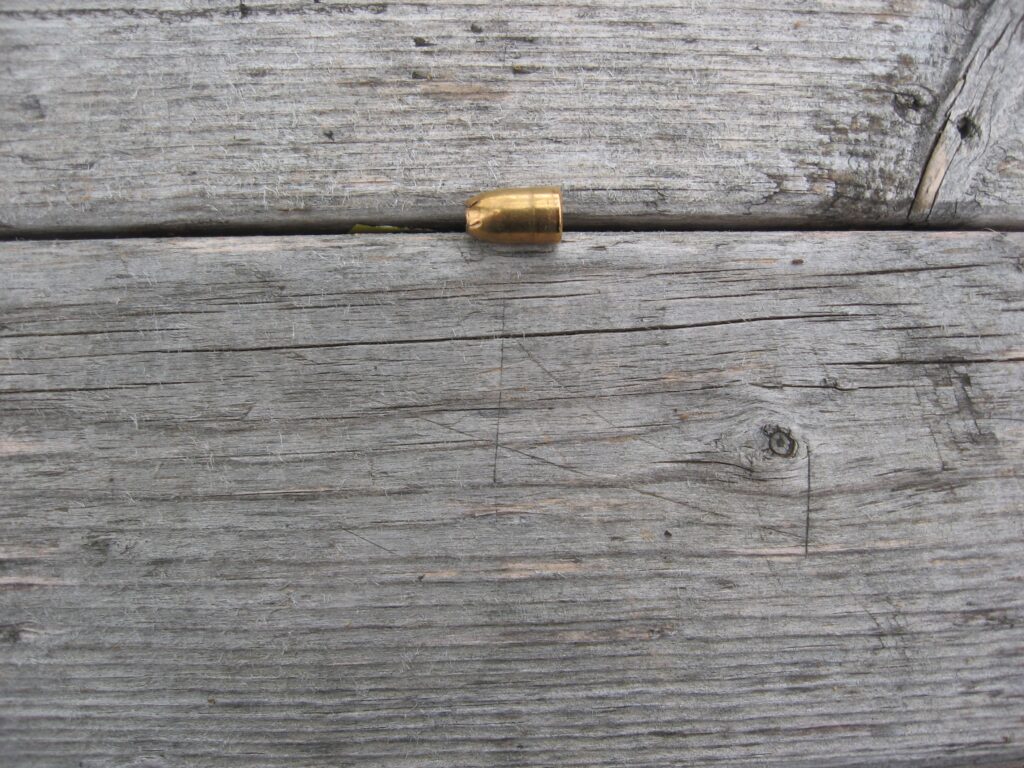BEAT THE 9MM SHORT CHAMBER BLUES WITH THE SNS CASTING 125 GRAIN ROUND NOSE.
By: Kevin Newberry
And with one of my favorite 9mm bullet styles, what I refer to as a RN-SWC. But before we go any farther I need to thank Jim Stinar at SNS Casting for supplying the bullets for this article. This is their version of the 125 gr. that they designate as a RN. They actually list two different bullets as 125 gr. Round Nose, so I’ll add a pic of the specific bullet I’m referring to.

The reality of most 9 X 19mm service pistols of today is that most come with a short chamber compared to 9 X 19mm pistols of yesteryear with a few exceptions. I’m not sure exactly how that got started, but my suspicion is that it began with CZ 75s that were first imported into the country after the wall fell and the collapse of the Soviet Bloc. It is interesting to note that those first CZ 75s that were imported were actually available – or at least advertised as such – chambered for two different 9mm rounds: the 9 X 19mm and the 9 X 21mm. Essentially, the only difference between the two was the barrel, and likely, the recoil spring. Magazines were identical as were the other parts.
For those who may not be aware, because of nations like Italy, in particular, civilians are not allowed to own pistols chambered for the same caliber as used by their military. Thus the Italians lengthened the case by two millimeters creating the 9 X 21mm. That cartridge was recently submitted by Israeli Weapons Industry for standardization, albeit a lower power cartridge than what we were first introduced to. If you’ve seen older handload data for the 9 X 21mm, such as Vihta Vuori once supplied, they loaded the cartridge up to as high as 42,800 PSI tested in the PSI system used by the Commission International Permanente in Europe. The Europeans use several units for listing pressure, another being BARs. If you’ve seen current European data you know that the Maximum Average Pressure, or MAP, for the 9 X 21mm is 2350 BARs, the same as for the 9 X 19mm. In their Pistol & Revolver III, Lyman did some testing of the newer and lower pressure version of the 9 X 21mm in attempt to reach Major Power Factor.
It seems obvious that CZ didn’t want the very high pressure 9 X 21mm loads of that time being accidentally loaded in pistols chambered for the 9 X 19mm. I don’t know of a case where that happened, or if it’s possible that a CZ 75 in 9 X 19mm could be fired out-of-battery with a cartridge whose case is 2mm longer. I always believed that they shortened their 9 X 19mm chambers as an added safeguard against 9 X 21mm ammunition being fired from 9 X 19mm models. I’ve also never heard of a CZ 75 chambered for 9 X 19mm for export into the United States, having a chamber throated any longer than those that first became available. As much as I like the CZ 75 design, I’ve only owned one CZ 75 chambered in 9 X 19mm with that being the excellent P-01 that so far as I know, was the first 9 X 19mm pistol submitted to NATO for their newly established testing protocol at that time, which of course, it passed. I’ve seen reaming their chambers discussed with mixed results, so for someone contemplating such a move I would recommend having the reaming done using a professional quality milling machine.
More recently, we’ve seen Glock shorten their 9 X 19mm chambers with the Gen V service pistol models 17 & 19 and the barrels they designate as Marksman. It really isn’t conducive for a company like Glock to be one of the very few “major” pistol manufacturer to offer barrels with generous throats while ammo-makers are making shorter rounds with the exception of the 124 gr. NATO round where everyone’s bullet is essentially the same shape. The greatest impact of short chambers is on JHP defense loads. But truth is, unless you’re loading 124 gr. 9mm NATO FMJ bullets of that one specific shape with its long and slender ogive, most others must be loaded shorter. One reason I always specify that whenever you try a new bullet for handloading, you must confirm that the length will work for the pistol it will be fired from. Consequently, if you handload for several different 9 X 19mm pistols, but only want to make a single load for them all at a specific OACL, it must be loaded for the pistol with the shortest chamber. Thus it long ago became my own practice to not buy 9 X 19mm pistol with a short chamber and why you see me list my test pistol as the Canik TP9sa. With it, it is possible with some bullets to load even longer than the SAAMI Max Spec for the 9 X 19mm OACL of 1.169”. And for those who may be wondering, the Max OACL for the 9 X 21mm is 29.70 millimeters in Europe and identical to that of the 9 X 19mm. Simple math will tell you that 29.7mms is the same as 1.169”.
So is there any advantage in longer loads? If you follow the credo from reloading rifle cartridges as I do, I like the bullet to be within .010” of touching the chamber’s leade if possible. A longer OACL in conjunction with a powders burn rate can also slightly reduce chamber pressure. Increased pressure is why your loads should not be any shorter than the length provided by the data you use. In the case of the Canik 9 X 19mm pistols like the TP9sa, the problem is actually in reverse to the short chamber issue in that the bullets, unless loaded very long, will not be within .010” of touching the leade. I’ve had good accuracy results with the lengths I use and have had better functioning in some cases. The loads I’ll be shooting for this report with the SNS Casting 125 gr. RN (SWC) have an OACL of 1.142”, or 29mm. I have used SNS Casting’s bullets even before they became poly-coated and they have all, including the poly-coated, been excellent.
I have them loaded with 3 different Western Powders: AA No 2, Ramshot ZIP and True Blue. I’ve had a small quantity of ZIP for some time waiting for a job, so I gave it one. I’ve lately been involved in discussions concerning recoil from different powders. AA No 2 is very close in burn rate to other powders typically used for Minor Power Factor loads where I aim for 130 PF; 1048 FPS with a 124 gr. Bullet, 884 FPS with a 147 gr. Bullet, and bullet weight is another part of that discussion. ZIP is quite similar to W231 while True Blue is the slower burner in this group, so charge-weight is slightly higher which we’ll get into with shooting and chrono results.
In many of my articles that can be found here, you’ll notice that they are oriented towards defense loads. For 124 gr. JHPs, I don’t typically load them longer than 1.142”/29mm, and when necessary for 100% functioning they can be as short as 1.122”/28.5mm, and of course, in-between at 1.132”/28.75mm. I’ve gotten in the habit, over the years, of changing OACLs by .25mm increments. For 147 gr. JHPs, they’re all pretty much at 1.142”/29mm. But again, the TP9sa allows for such lengths where other pistols often require a shorter OACL. I have loaded the 147 gr. XTP as long as 1.152”/29.25mm.
Getting back to that CZ P-01, back when bulk bullet prices were rational and progressive government not being in the majority headed in reverse, I loaded tens of thousands of the old-style Remington 124 gr. JHPs. Not that I didn’t load the 124 gr. Golden Saber, but overall, the older style was more accurate in my loads. I was still loading on a REDDING Boss single-stage press back then that kept very tight tolerances for OACL. So with the method I’ve described previously, and I suppose how it originated, was for the P-01 and the Remington 124 gr. JHP. At the point where the bullet touched the leade, where the bullet was hand seated into a FIRED case by the leade, what I refer to as Max Possible OACL, was 1.127” for that combination while my handloads measured 1.122”/28.5mm. And the P-01 liked that load very well, particularly those I charged with True Blue. And here’s a link to that past article:
Obviously, we are not discussing defense loads here, but I will mention one later that is relevant to this discussion.
The reason I like the RN-SWC style like I do is that it can be loaded longer for short-chambered pistols. Then comes another element as I was instructed by my load manuals for loading SWCs in .45 ACP with 1/32” of the bullet’s shoulder being above the case rim. Not exactly what I’m getting with these 9mm loads, but close enough. There isn’t much possibility that the bullet’s shoulder could contact the leade. And then above this bullet’s shoulder I’m measuring a diameter of .338” and smaller than the barrel’s land diameter. Loading with this method has produced excellent accuracy with this style of bullet in a number of different pistols.
I’ll also address a question that gets asked occasionally regarding auto-pistol chamber gauges. The simple reality is that the tool companies will make the products we ask for, but the best chamber gauge is the chamber in YOUR pistol’s barrel. On more than one occasion, I’ve seen chamber gauges, or go, no-go gauges, give a pass to a cartridge that doesn’t fit in a particular pistol’s chamber. As with most things mechanical, there are tolerances plus and minus. All auto-pistol rounds must plunk and spin!
So here we are at a good point to discuss the terms throat and leade. In most cases they mean the same to us. That was the case in the SPEER #11 manual from 1987. If you check its glossary for the term Leade, it says see Throat or Freebore. Look up those two words and you’ll be referred to the others. The most common term seems to be throat and SPEER defines it in the following way: “The area of the bore immediately ahead of the chamber; tapers to the point where the rifling starts.”
That tapering occurring on the barrel’s lands to a reduced diameter, and less than bullet diameter. SAAMI and others have specifications for these dimensions, as well as a tolerance range. But just as the case with Taper Crimp dies, all tapers are not created equal. The shorter the taper is, the sharper the angle it is set at, and that can be a problem for many JHPs. A sharper degree of angle will require a shorter cartridge length vs a less severe taper angle. UNLESS that bullet happens to be what is standard for most of the world’s 9mm service pistols: the 8-gram FMJ, more commonly known as the 124 gr. NATO FMJ in the US. Its ogive is long and slender enough to feed without touching the throat until it is loaded longer than most of us do. But if you want to load a 124 gr. JHP as long as say 1.142”/29mm as I sometimes do, its ogive can’t differ much from the 9mm NATO bullet shape. Typically, the shorter the JHP bullets ogive or truncated cone is, the shorter you’ll need to load it unless you happen to have one of the few 9mm pistols that still allow for loading JHPs to a longer OACL. Thus, the shorter lengths required are mandated by the component suppliers handload data.
I have actually used the 124/125 gr. RN-SWC bullet-style long before poly coating began. And I basically used the same suggestion that applies to .45 ACP SWCs allowing about 1/32”/.7938mms of the bullet’s shoulder to be above the case-mouth. But let me simplify: Load the SNS Casting 125 gr. RN (SWC) to an OACL of 1.142”/29mm and the amount of shoulder exposed above the case-mouth will be 1mm or less. It also means you’ll have a substantial amount of the full diameter portion of the bullet seated in the case. And as mentioned before, bullet diameter above the shoulder is reduced to .338” with the sample I’m using and adding a pic of.
I’ve mentioned many times in many places that I’ve hardly ever loaded FMJ bullets. The bullet I’m writing about here will do anything as well as the same weight FMJ. And back when we didn’t have the options that exist today, back when 1K of the Remington 124 gr. JHP and Golden Sabers were under $45/K, FMJ was sold at nearly the same price. Cast lead had the greater lower price differential, and all of those that I used were plenty hard, at least 16 BHN, while diameter was .356”. I just never had any leading problems and slugging the bores I loaded them for were never larger than .355”. There are some that will state a preference for .357” diameter for 9mm bullets, and sometimes accuracy is their particular reason for that, but understand that the larger the bullet’s diameter is, the greater pressure will be as a result. Probably not an issue for gaming loads at around 130 PF, but if you want to load a less expensive bullet at the same velocity as your JHP load to better balance the recoil between the two, a diameter of .356” works fine for that, and now even better with poly coating added. I will also note that back then, short chambers in 9 X 19mm barrels were NOT the norm, but rather the exception. That has had a great effect on 9mm JHP defense loads as well. The ammo makers have to make their loads short enough to ensure that they won’t be too long for a barrel’s chamber, regardless of who the pistol-maker was. I’ve never been what you would call a Glock devotee, but I have owned a few in 9mm and .40 S&W. Mainly Gen 2 G19s that had no chamber-length restrictions except their magazines. But it does not behoove a pistol-maker to use generous throated chambers when 9mm JHP defense loads are made for shorter throated pistols. Thus the change for Gen V G19 & 17s with the designation, “Marksman” barrel. Now look up “Freebore” and maybe you’ll understand why I used the term generous.
The longer you handload the fewer differences you’ll find between making pistol ammo and rifle ammo. Just as with rifle loads, you may find best accuracy with an optimum amount of freebore. Making your handloads .010” or .25mms shorter than the maximum length the chamber will allow is a good place to start. The reality is that with many 9mm service pistols of today, that OACL may not be much longer than what’s recommended in your handload data. One reason I tend to look toward brands that do not use short chambers as is the case with the Canik TP9sa that I use for handload testing. Unless they’ve changed recently, SIG and Ruger 9mm pistols are not typically short chambered, and of course the SIG P320 carries a NATO Spec where it must conform to the ammo used, and the Ruger American was designed with the latest US Military Pistol (modular) contract in mind. I’m personally excited that in the past few days Ruger has announced a 5” barrel “Competition” version of their American Pistol. I don’t own either as yet, so I haven’t confirmed any chamber dimensions. A few years back I used a Ruger SR9 for handload testing, with maybe its more relevant barrel length of 4.14”. I could make my JHP loads as long as I wanted them so long as they fit and functioned correctly in the magazine. That was true of the “P” series pistols before and of course the SIG P226 I bought back in 1998. Everyone has a preference, and mine happens to be service pistols with barrels over 4.5”, although the TP9sa barrel measures a shade under that at 4.47” and the P226 being 4.42”. I have to admit that the new Ruger 9mm Competition model with its 5” barrel is attractive to me personally. It also has a slower rate of twist at 1 in 16” rather than the more typical 1 in 10” twist for better accuracy from higher velocity loads. And the Americans being rated for sustained use of 9mm +P certainly doesn’t hurt. Not for a guy that was handloading 9 X 19mm ammo before the +P designation arrived. If there is any question of a 9mm pistol not being up to the task of at least some practice ability with 9mm +P ammo, it’s not for me. YMMV!

You can see the amount of the bullet’s shoulder that is above the case-mouth. There’s a quick little check you can make with the barrel removed from the pistol to know that the bullet will not touch the lands in the barrel.

Now let’s get to the tale of the tape with 10 random sample bullets. The first number that should please all is the very consistent diameter of .3565”. That’s reading the dial hand midway between .356 and .357” on my trusted Mitutoyo dial caliper. That should please those who might prefer a bit larger diameter, but not enough greater than .356” to have much effect on pressure. Average weight comes in at 123.66 grs with the majority being 123.5 while the single highest weight was 123.9 grs. Pretty good in my book.
I fired the first batch of loads on 3/12/20. As mentioned, 1.142”./29mm was the length and it was consistent. The first load came closest to 1048 FPS/130 PF when we consider weight is 124 grs. All loads had a CCI500 primer and all strings were for 10 rounds. 4.0 grs. Of AA No 2 chrono’d 1039 FPS for 128.8 PF/ Extreme Spread was 36 with Standard Deviation at 10 FPS. Next was 3.9 grs. Of ZIP at 959 FPS with an ES of 53 and an SD of 17 FPS. Obviously that can be improved with a slightly higher powder charge while using the longer OACL. Then the third load was with 4.9 grs. Of True Blue at 988 FPS with an ES of 39 and SD of 12 FPS. Good enough for a starting point because in my experience with True Blue, and knowing I’ll need to increase the charge to reach the velocity/PF goal, I can just about guarantee that ES and SD will lower as velocity increases, and there’s a bit more room for a powder charge increase since the Max standard pressure charge was 5.0 grs. of True Blue for the 124 gr. LaserCast that was loaded much shorter at 1.050” in the Western data.. The data for powder charges with that bullet was used throughout while my longer OACL definitely lowered pressure and velocity. A 1/10th grain increase of No 2 should have me very close, but I’ll likely look closest at True Blue where at 1048 FPS, a 60 FPS increase, I expect to see a significantly lower SDs. Thereafter I’ll be loading with True Blue at higher velocity to give me a good practice load with recoil a bit closer to my 124 gr. JHP defense loads. Using this same bullet with True Blue previously and fired from the 4.14” Ruger SR9 I reached a velocity of 1122 with an ES of 12 FPS and an SD of 3 FPS. I’ll be working up in .2 gr. increments of powder charge with True Blue to see what happens at that same velocity from the 4.47” Canik. With the previous load of several years ago I would expect velocity to climb from 1122 FPS to around 1150 FPS. And as is the case for .45 ACP 200 gr. SWCs that I shoot, the holes in the target are nicely defined. Another reason I really like this style and bullet weight: it’s just plain fun to shoot!
Now one of my articles just wouldn’t be the same without mentioning at least one potential defense load. And this one shares the merits of having a smaller diameter above the shoulder, except that Remington refers to the full caliber portion of the bullet as the “Driving Band” and it isn’t greatly different than using the SNS Casting RN (SWC). With your barrel removed after clearing the pistol, the 124 gr. Golden Saber will also drop right into the muzzle. Let’s examine a pic.

Only the driving band is .355” in diameter. The diameter just above the driving band is .348” and smaller than land diameter. In fact, Remington loads this bullet to around 1.145” OACL and that is the same length listed in the Western Powder’s data. There are some interesting things that have evolved with this bullet over the many years I’ve handloaded it. More than 20 years ago came reports that the core and jacket could separate. At that time I had not seen that occur; maybe due to the age of the bullets I had on hand and I gave it a variety of challenges that I felt would induce separation. I didn’t worry much about it, but began working with a number of other bullets and was already using the standard Remington 124 gr. JHP. It was simply more accurate and a bit more cost-effective. Some years later I went back to testing the Golden Saber and a load that matched the factory loaded +P version spec exactly at 1180 FPS. The core and jacket separated. I began investigating a way to prevent that which lead to a higher velocity load. All was good for a while until the bullets in that load also began separating.
This is where things get interesting, and I’ve discussed this with Charles Schwartz on several occasions. Loading the 124 gr. Golden Saber up to 1250 FPS and +P where proper powder selection is absolutely required, and the OACL of 1.145”, the Golden Saber will still separate. That does not, however, impede its penetration while it has always been a great expander. Shooting into those infamous 1 – gallon water jugs, the jacket penetrates as deeply as the core. Maybe a negative unless you consider that it creates a second wound channel. But again, the separation does not prevent the bullet from penetrating very well. On the other hand, if the designers at Remington were interested, the problem seems solvable if the inside of the jacket reflected the shape outside of the jacket and having two different diameters for the driving band then reducing the diameter of the bullet above the driving band just as it appears, with little difference in the thickness of the jacket. That would create a mechanical lock with the lead core being greater in diameter to fit tightly within the driving band. I’ve only examined one unfired core that was without its brass jacket, and obviously a defect, but there was little dimensional difference until you got to near the core’s ogive. Undoubtedly, changing the manufacturing technique could be very expensive, and Remington has taken a different track with the Black-Belt version that does provide a mechanical lock of the jacket to the core. So is the standard Golden Saber a good defense bullet? That’s a question you must answer for yourself.
As always, God Bless, Be Safe and Good Shooting to you all!
Kevin
